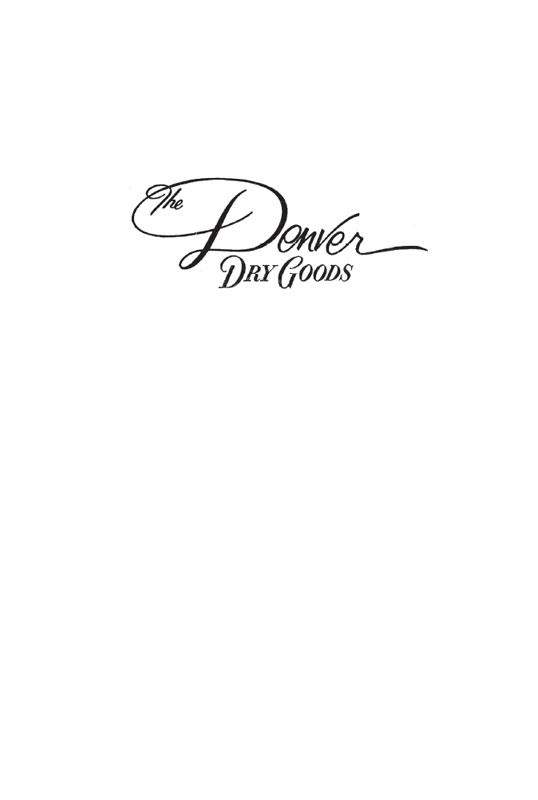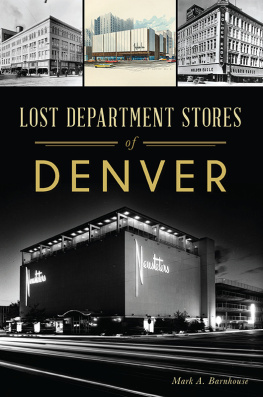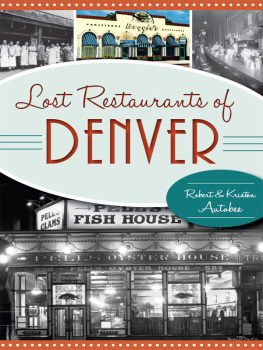


Published by The History Press
Charleston, SC
www.historypress.net
Copyright 2017 by Mark Barnhouse
All rights reserved
Front cover: Authors collection.
First published 2017
e-book edition 2017
ISBN 978.1.62585.807.8
Library of Congress Control Number: 2016961491
print edition ISBN 978.1.46713.536.8
Notice: The information in this book is true and complete to the best of our knowledge. It is offered without guarantee on the part of the author or The History Press. The author and The History Press disclaim all liability in connection with the use of this book.
All rights reserved. No part of this book may be reproduced or transmitted in any form whatsoever without prior written permission from the publisher except in the case of brief quotations embodied in critical articles and reviews.
To the memory of Horace Alfred Pratt, 19161975
CONTENTS
FOREWORD
The Denver: a division of Associated Dry Goods Corporation, one of the leading retail organizations in the United States with fourteen major divisions throughout the country. The Denver: Where Denver Shops with Confidence. The Denver: Where Colorado Shops with Confidence.
By the time we arrived in the mid-1970s, The Denver had been serving customers in the Rocky Mountain region for over eighty years. By building on its reputation for premier service, merchandise selection, quality and value, together with a philanthropic commitment to the well-being of the markets in which it operated, the company achieved record sales and profits during the decade that followed. It was an exciting time for us, bringing products from around the globe to a community rapidly growing in consumer sophistication.
We were fortunate enough to join The Denver Dry Goods Company at a turning point in its history. From the early 1970s, it began a rapid expansion along the Front Range. Full-line department stores were opened in Colorado Springs, Southglenn, Aurora, Englewood, Northglenn and Southwest Plaza. Full fashion stores opened in Fort Collins, Boulder, Pueblo and Billings, Montana. These new stores joined Downtown, Cherry Creek, Lakeside and Greeley.
The Denver quickly became the leading retail powerhouse and the upscale leader of quality fashion merchandise. The growth occurred because of its acceptance by a strong customer base, parent company Associated Dry Goods commitment to a constant, strong senior management group and the training and development of its people. All of this resulted in superior financial results and the backing of its corporate ownership.

A 1930s40s roadside billboard advertises the store Where Colorado Shops with Confidence. Linda Lebsack collection.
A strong organization with highly developed and motivated employees who stayed with the company and grew with it fed the ability to have strong merchandising trends that were based on quality and fashion. These merchandising concepts were widely accepted by the consumer.
It is, however, our colleagues and associates who provide our most enduring memories. Their dedication to making it the store where Denver shops with confidence was the driving force for success. A history of The Denver that doesnt recognize the accomplishments of these outstanding men and women would be incomplete.
When it came time to say goodbye after ninety-one years because of a corporate buyout on the New York Stock Exchange, it was front-page news for many months on the Denver Post and the Rocky Mountain News. Thus, a strong institution of over three thousand employees committed to a culture of excellence was lost to the retail community and its customers forever.
Many thanks go to Mark Barnhouse for allowing us to be part of this history. There are still many of us who remember our years with The Denver with great fondness and pride. We are proud to have been a part of this exceptional enterprise.
F. Joseph Hayes and James J. OHagan
F. Joseph Hayes was the last president of The Denver Dry Goods Company, serving in that position from 1980 until 1987. He had previously served as assistant treasurer and as vice-president/chief financial officer. James J. OHagan was The Denvers last vice president of operations, serving from 1978 until 1987, after a career there that began in 1973.
ACKNOWLEDGEMENTS
The writing of a book is usually thought of as a solitary pursuit, but no author, including myself, could produce the history of a great department store such as this one without the help of many other people (listed here in roughly chronological order). I am indebted to Dr. Colorado, Thomas J. Noel, who provided his usual sage advice, along with some fine photos from his collection. I am deeply thankful to Colorados foremost dealer in western Americana, Linda Lebsack, for her timely discovery and sharing of a cache of documents and photographs related to The Denver Dry Goods Company. Two former Denver Dry Goods executives, F. Joseph Hayes and James J. OHagan, shared their memories and observations, which I greatly enjoyed and which informed the text. Thanks to Joe and Jim, too, for their wonderful contribution to this book in writing its foreword and to Jim for sharing his extensive collection of Denver Dry Goods memorabilia. Architectural historian Dr. Kathleen Corbett pointed me toward the works of Richard Longstreth, which have proved invaluable to my understanding of the ways department stores evolved over the twentieth century. Current residents Mark Bochnak and Richard Bruce gave me a tour of the Denver Dry Goods Building so that I could get a better understanding of its transformation into a residential/commercial adaptive reuse project that wonderfully preserves a Denver landmark. Bill Eloe kindly allowed me to use a very rare image from his collection of nineteenth-century western photography. As always, I thank the wonderful staffs of the Western History and Genealogy Department of the Denver Public Library, the Stephen H. Hart Library of History Colorado (particularly photo research librarian Melissa Van Otterloo), the Colorado Railroad Museum (collections curator Stephanie Gilmore and volunteer Bill Brown) and the Special Collections department at the Auraria Library. As she has done for all of my previous books, Coi Drummond-Gehrig, digital image collection administrator of the Denver Public Library, located some wonderful photographs that I wasnt able to find myself, for which I am deeply grateful. Too numerous to name individually, I give collective thanks to the many vendors at the Denver Post Card Show and the Rocky Mountain Book and Paper Fairthese events are great resources for historians and for people who just love historical things. Finally, thanks go to my editor at The History Press, Artie Crisp, who provided helpful advice and encouragement throughout the process.
Introduction
THE END OF AN ERA
No one can claim to live in the civilized world if he doesnt have a big department store across the street from where he works. If I wanted to, I could walk over there in 45 seconds, buy a new suit, shirt, tie, socks and shoes, and be transformed into someone really important-looking almost as fast as Superman could get in and out of his phone booth. Ive always told myself Id do that silly trick someday when I had the money, and now it appears Ive let another one of the downtown Denverites delights slip through my fingers.
Next page












